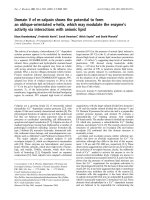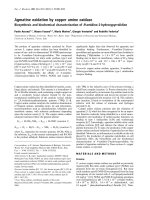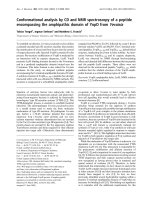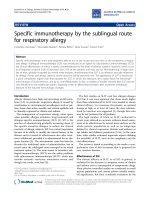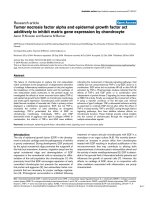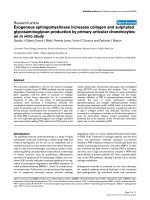Báo cáo y học: "Drug efficacy by direct and adjusted indirect comparison to placebo: An illustration by Mycobacterium avium complex prophylaxis in HIV" potx
Bạn đang xem bản rút gọn của tài liệu. Xem và tải ngay bản đầy đủ của tài liệu tại đây (229.45 KB, 6 trang )
SHOR T REPOR T Open Access
Drug efficacy by direct and adjusted indirect
comparison to placebo: An illustration by
Mycobacterium avium complex prophylaxis in HIV
Jennifer Chu
1*
, Caroline E Sloan
1
, Kenneth A Freedberg
1,2,3
, Yazdan Yazdanpanah
5
, Elena Losina
3,4
Abstract
Background: Our goal was to illustrate a method for making indirect treatment comparisons in the absence of
head-to-head trials, by portraying the derivation of published efficacies for prophylaxis regimens of HIV-related
opportunistic infections.
Results: We identified published results of randomized controlled trials from the United States in which HIV-infected
patients received rifabutin, azithromycin, clarithromycin, or placebo for prophylaxis against Mycobacterium avium
complex (MAC). We extracted the number of subjects, follow-up time, primary MAC events, mean CD4 count, and
proportion of subjects on mono or dual antiretroviral therapy (ART) from each study. We derived the efficacy of each
drug using adjusted indirect comparisons and, when possible, by direct comparisons. Five articles satisfied our inclusion
criteria. Using direct comparison, we estimated the efficacies of rifabutin, clarithromycin, and azithromycin compared to
placebo to be 53% (95% CI, 48-61%), 66% (95% CI, 61-74%), and 66% (95% CI, 60-81%), respectively. Using adjusted
indirect calculations, the efficacy of rifabutin compared to placebo ranged from 41% to 44%. The adjusted indirect
efficacies of clarithromycin and azithromycin were estimated to be 73% and 72%, respectively.
Conclusions: Accurate estimates of specific drug dosages as compared to placebo are important for policy and
implementation research. This study illustrates a simple method of adjusting for differences in study populations by
using indirect comparisons in the absence of head-to-head HIV clinical trials.
Background
Cost-effectiveness analyses a re frequently used to guide
health policy deci sions, particularly in HIV disease[1-3].
To offer long term projections on clinical and economic
implications to specific treatment strategies and to
address the need to make clinical decisions where
evidence from published studies is insuffi cient, cost-
effectiveness analyses offer strategic insights using
model-based evaluations. Model s used in cost-effective-
ness analyses are often multidimensional and based on a
large number of input parameters. In such model-based
evaluations, efficacy estimates of drug regimens com-
pared to placebo are critical for accurate delineation of
alternative treatment strategies and cost-effectiveness
comparison s. Howev er, head-to-head placebo-controll ed
trials often are not feasible; they are expensive, time-con-
suming, and unethical if guidelines for a pharmaceutical
intervention already exist [4]. Adjusted indirect comparison
of randomized controlled trials has become an increasingly
accepted method for assessing the effect of pharmaceutical
interventions on survival outcomes, in the absence of pla-
cebo-controlled trials [5-8]. Within the framework of a
cost-effectiveness model, often based on hundreds of para-
meters, it is not always feasible to use complex methods to
derive every input parameter, especially for parameters not
likely to affect major policy decisions.
Our goal was to ill ustrate a simple method for ad just-
ing drug efficacy estimates according to differences in
disease severity to derive parameters for a complex com-
puter simulation model of HIV disease [1,9]. One study,
for example, may compare regimen A to regimen B, and
another study m ay compare regimen B to placebo.
Adjusted indirect comparison provides a method for
establishing the efficacy of regimen A compared to
* Correspondence:
1
Division of General Medicine, Department of Medicine , Massachusetts
General Hospital, Boston, USA
Full list of author information is available at the end of the article
Chu et al. AIDS Research and Therapy 2011, 8:14
/>© 2011 Chu et al; licensee BioMed Central Ltd. This is an Open Access article distributed under the terms of the Creative Commons
Attribution License ( which permits unrestricted use, distribution, and reproduction in
any medium, provided the original work is properly cited.
placebo, without losing the positive attributes of
randomization.
Previous studies using adjusted indirect comparison
estimated one-time probabilities and pooled the effica-
cies of drug regimens with varying doses [5,7,10,11].
Here, we establish a method for determining the efficacy
of specific drug doses over time, thus allowing for pre-
dictions of treatment failure after any duration of ther-
apy. We focused our illustration on prophylactic drugs
for Mycobacterium avium complex (MAC) in patients
infected with the human immunodeficiency virus (HIV)
in the United States, because national guidelines recom-
mend administering specific drugs and d oses to prevent
MAC [12]. Moreover, we also selected MAC as our
illustration because of the availa bility of placebo-con-
trolled trials for each guideline-recommended drug.
Methods
Study selection
We performed a MEDLINE search to identify randomized
controlled trials of primary prophylaxis against MAC that
were consistent with the current United States prophylaxis
guidelines for HIV-infected patients[12]. We used the fol-
lowing search terms: Mycobacterium avium complex, ran-
domized-controlled trial, placebo, rifabutin, azithromycin,
and clarithromycin. We then reviewed the bibliographies
of selected articles to identify other relevant studies. We
considered data from randomized controlled clinical trials
that reported follow-up time and administered primary
prophylaxis for MAC, using one of the following drug
regimens: 300 mg rifabutin once daily, 1200 mg azithro-
mycin once weekly, or 500 mg clarithromycin twice daily.
These doses are based on the 2009 “Guidelines for Preven-
tion and Treatment of Opportunistic Infections in HIV-
infected Adults and Adolescents” [12]. To be included in
this analysis, studies had to hav e at least two treatment
arms and compare prophylactic regimens either to placebo
directly, or to one another. Data o n the number of sub-
jects, follow-up time, and primary MAC events are
included in Table 1. We collected additional data on mean
CD4count,numberofpatientsonmonoordualantire-
troviral therapy (ART), endpoint definitions, and inclusion
or exclusion criteria from each study. For one pair of iden-
tically designed studies, we derived efficacy using the
weighted averages of data from the two studies [13].
Direct comparison
If Trial 1 compared regimen A to placebo, we used
Equation 1 to derive the efficacy of regimen A relative
to placebo.
Efficacy A =1−
Monthly Prob of failure A
Monthly prob of failure Placebo
(1)
We determined the two-sided 95% confidence interval
(CI) of each efficacy derived by direct comparison.
Adjusted indirect comparison
When direct comparison of a drug regimen to placebo
was not possible, we made adjusted indirect compari-
sons. For example, when trial 1 compared regimen A to
placebo, and trial 2 compared regimen B to regimen A,
we computed a “correction” factor to adjust for differ-
ences in baseline characteristic differences, including
mean CD4 count and number of patients on ART,
between the subjects of trial 1 and trial 2. The correc-
tion factor preserved the balance between the two ran-
domized groups. Using Equation 2, we derived a
correction factor to compare regimen A of trial 2 to
regimen A of trial 1.
Correction Factor A =
Monthly prob of failure A, trial2
Monthly prob of failure A, trial1
(2)
We then used Equation 3 to calculate the adjusted
monthly probability of failure of regimen B.
Adjusted monthly prob of failure B = (Correction factor A)∗(Monthly Prob of failure B)
(3)
This adjusted monthly probability of failure allowed us
to compare regimen B in trial 2 to placebo in trial 1.
We obtained the efficacy of regimen B using Equation 4.
Efficacy B =1−
Adjusted monthly prob of failure B
Monthly prob of failure Placebo
(4)
We compared the direct and adjusted indirect effica-
cies of each regimen to assess the validity of adjusted
indirect comparisons.
Results
Characteristics of eligible trials
We identified five eligible randomized controlled trials
that included a total of 3,222 subjects (Table 1). Three stu-
dies compared one drug regimen to placebo, and two trials
compared different prophylaxis regimens to each other.
Efficacy by direct comparison
We used data from three studies, by Nightingale et al.,
Pierce et al., and Oldfield et al.tocomparerifabutin,
clarithromycin, and azithromycin to placebo, directly
(Table 2) [13-15]. The absolute efficacies of rifabutin,
clarithromycin, and azithromycin, each compared to pla-
cebo, were estimated to be 53% (95% CI, 48-61%), 66%
(95% CI, 61-74%), and 66% (95% CI, 60-81%).
Efficacy by indirect comparison
After adjusting the failure rate of rifabutin in the Benson
et al. study to baseline characteristics in the Pierce et al.
Chu et al. AIDS Research and Therapy 2011, 8:14
/>Page 2 of 6
study [14,16], we estimated the adjusted indirect efficacy
of rifabutin in Benson et al. to be 41%. Similarly, we com-
pared rifabutin in Havlir et al. to placebo in Oldfield et al.,
because both studies contained one azithromycin arm
[15,17] . The efficacy of rifabutin in Havlir et al. was 44%,
compared to placebo in Oldfield et al.
When we adjusted the results of the Benson et al.
study to baseline characteristics in Nightingale et al.,
using the rifabutin arms in each study, we estimated the
efficacy of clarithromycin in Benson et al. compared to
placebo in Nightingale et al. to be 73% [13,16]. When
we adjusted the results of the Havlir et al.studyto
Table 1 Characteristics of 5 randomized controlled trials of primary prophylaxis against Mycobacterium avium complex
in HIV-infected adults
Study Drug dose No.
subjects
Mean CD4
Count
a
(cells/μl)
%On
ART
Median Follow-
up time
b
(days)
Primary MAC
events (N)
Direct monthly
failure rate
(95% CI)
Direct
monthly
probability
of failure
Nightingale 1993, study
023 and 027
c
[13]
Rifabutin, 300
mg, qd
283 64 100 209
d
24 0.012 (0.007-0.017) 0.012
Placebo 290 56 100 202
d
51 0.027 (0.019-0.0034) 0.026
Havlir 1996 [17] Rifabutin, 300
mg, qd
223 47 – 514 52 0.014 (0.010-0.018) 0.014
Azithromycin,
1200 mg, qwk
223 49 – 514 31 0.008 (0.005-0.011) 0.008
Benson 2000 [16] Rifabutin, 300
e
mg, qd
391 30 75 574 59 0.008 (0.006-0.010) 0.008
Clarithromycin,
500 mg, bid
398 27 73 595 36 0.005 (0.003-0.006) 0.005
Pierce 1996 [14] Clarithromycin,
500 mg, bid
333 30 – 427
f
19 0.004 (0.002-0.006) 0.004
Placebo 334 25 – 402
f
53 0.012 (0.009-0.015) 0.012
Oldfield 1998 [15] Azithromycin,
1200 mg, qwk
85 44 – 400
d
9
g
0.008 (0.003-0.013) 0.008
Placebo 89 44 – 340
d
24
g
0.024 (0.015-0.034) 0.024
qd: once a day; bid: twice a day; qwk: once a week; MAC: Mycobacterium avium complex; ART: antiretroviral therapy; CI: confidence interval
a
At baseline.
b
All patients on ART were on dual or mono therapy
c
Study 023 and 027 are two identically designed studies. We calculated weighted averages the number of subjects, follow-up time, and number of new MAC
events for the two studies.
d
Duration on treatment
e
This study was originally designed with a 450 mg qd dosage but reduced to 300 mg qd after 9 months.
f
Mean follow-up time
g
The primary endpoints of this study were MAC symptoms and positive culture. We only included culture-positive events, to remain co nsistent with the other
studies, which all used positive MAC cultures as primary endpoints.
Table 2 Efficacy of MAC regimens by direct and adjusted indirect comparison
Drug dose and study Method of efficacy
derivation
Study used for
comparison
Correction
factor
Adjusted monthly probability
of failure
% Efficacy
(95% CI)
Rifabutin, 300 mg, qd
Nightingale 1993 [13] Direct –– – 53 (48-61)
Havlir 1996 [17] Adjusted indirect Oldfield 1998 0.979
a
0.014 44
Benson 2000 [16] Adjusted indirect Pierce 1996 0.879
b
0.007 41
Clarithromycin, 500 mg, bid
Pierce 1996 [14] Direct –– – 66 (61-74)
Benson 2000 [16] Adjusted indirect Nightingale 1993 1.542
c
0.007 73
Azithromycin, 1200 mg, qwk
Oldfield 1998 [15] Direct –– – 66 (60-81)
Havlir 1996 [17] Adjusted indirect Nightingale 1993 0.896
d
0.007 72
Comparison of the monthly failure probabilities of:
a
Compared to azithromycin in Oldfield 1998 [15].
b
Compared to clarithromycin in Pierce 1996 [14]
c
Compared to rifabutin in Nightingale 1993 [13]
d
Compared to rifabutin in Nightingale 1993[13]
Chu et al. AIDS Research and Therapy 2011, 8:14
/>Page 3 of 6
baseline characteristics in Nightingale et al.usingthe
rifabutin arms in each study [13,17], we estimated the
efficacy of azithromycin in the Havlir et al.tobe72%,
compared to the Nightingale et al. placebo arm.
Comparison of direct and adjusted indirect comparison
methods
The efficacies of clarithromycin and azithromycin
derived by adjusted indirect comparison were not signif-
icantly different from the efficacies derived by direct
comparison. However, our estimate of the efficacy of
rifabutin by indirect comparison (41-44%) was signifi-
cantly lower than the efficacy derived by direct calcula-
tion (53%).
Discussion
Thi s paper illustrates a simple method that can be used
to estimate input values for auxiliary parameters in mul-
tidimensional cost-effect iveness models. Since thorough
methodological expertise i n indirect comparisons may
not always be accessible, the method illustrated in this
paper could be used to derive efficacy of treatments
where direct trials based on data are not readily avail-
able. To establish the efficacy of a drug regimen, it is
necessary to compare outcomes for patients on and off
therapy. While it is sometimes possible to derive this
information directly from the results of randomized
controlled trials, clinical trials are expected to provide
enrolled participants with the best proven treatment, or
at least the standard of care [4]. Thus, most studies
compare different treatment options; studies that admin-
ister placebo to some subjects despite existing and
accepted treatment options for the disease of interest
lack equipoise and therefore are not ethical or feasible
[4]. In this paper we have illustrated a simple method
for indirectly estimating the dose-specific efficacy of
drug regimens from reported results of randomized con-
trolled trials without placebo arms by a straightforward
adjustment for baseline clinical severity. When possi ble,
we estimated the efficacies directly from the trials.
We found that the derived adjust ed indirect efficacies
of clarithromycin and azithromycin were similar to cor-
responding direct efficacies. However, the indirect effi-
cacy of rifabutin was significantly lower than the efficacy
derived by direct comparison. Unlike most other studies
used in this analysis, the Nightingale et al.study
reported mean duration on treatment, which is shorter
tha n mean follow-up time. This substitution may there-
fore have led to an overestimation of the direct efficacy
of rifabutin. The greater efficacy of rifabutin in the
direct comparison may also be attributed to the greater
proportion of patients on ART in this trial.
Our proposed method was consistent with that of pre-
vious studies showing that adjusted indirect comparison
reduces bias in drug efficacy calculations [ 5-7,11]. Our
inclusion criteria were stricter than those in previous
studies, because we examined outcomes only from trials
that compared d rug regimens with specific doses and
that provided results at several time points. Thus, we
avoided having to pool results fro m various doses of the
same drug regimen. Our results may be more accurate
than previous studies for the spec ific doses exa mined,
since we only included trials that administered the doses
recommended in the United States “Guidelines for Pre-
vention and Treatment of Opportunistic Infections in
HIV-Infected Adults and Adolescents”[12]. Similar
results may be obtained using Indirect Treatment Com-
parisons (ITC) Software from the Canadian Agency for
Drugs and Health Technologies [18]. While this offers a
means of validation of the methods in this paper, a
step-by-step description may be useful to t hose who do
not have direct access to the ITC software, or for
further understanding of the insights provided.
One of the main purposes of the indirect comparisons
is to make stronger inferences about comparisons being
studied. We recognize the scarcity of placebo-controlled
trials in the HIV/AIDS field, particularly amon g newer
trials, and we believe that using older placebo-controlled
trials, as we have done in our illustration, for the purpose
of adjusted indirect comparisons, is acceptable. Our
study was limited by the number of studies that could be
used to derive OI prophylaxis efficacy. Only five studies
met the inclusi on criteria. However, because the focus of
this analysis was to illustrate simple and replicable meth-
odology for adjusted indirect comparison of drug regi-
mens, the small number of included studies does not
deter from this goal. Moreover, two studies did not
report follow-up time [13,15]. For these studies, we cal-
culated efficacy by substituting fol low-up time with mean
duration on treatment to calculate efficacy. The Oldfield
et al. study was terminated early because administering
placebo became inappropriate when the results of a sepa-
rate azithromycin efficacy trial [15]. It may be reasonable
to assume that most patients were on treatment at the
time of study discontinuation, and thus that the unre-
ported mean follow-up time is very similar to the mean
duration on treatment. However, treatment duration in
the Nightingale et al. study may have been greater than
the true unreported mean follow-up time, and could
have led to an overestimation of the efficacy of rifabut in.
While this method offers a useful approach for derivation
of point estimates, an extensive set of sensitiv ity analyses
are necessary to examine the robustness of policy conclu-
sions to uncertainty in parameter values. If a parameter is
influential, more so phisticated methods should b e
employed to obtain a more precise value of parameter.
The prevalence of MAC and other opportunistic infec-
tions among HIV-infected patients in the United States
Chu et al. AIDS Research and Therapy 2011, 8:14
/>Page 4 of 6
and Europe has greatly decreased since the earlier years
of the HIV epidemic, due to the success of co mbination
antiretroviral therapy [19]. However, methods presented
in this study continue to be applicable to resource-
limited settings, where the use of opportunistic infection
prophylaxis in the absence of ART is still widespread. In
the se area s, the WHO recommends lifelong prophyl axis
for fungal and bacterial infections, as well as for Pneu-
mocystis carinii Pneumonia with drugs such as fluc ona-
zole and cotrimoxazole [20]. In the United States,
recommendations for the p revention of opportunistic
infections continue to be revised regularly in the
national guidelines [12,21,22]. Similar indirect compari-
son methods may be useful in compar ing effective first-
line antiretroviral regimens in the United States and in
many countries–such as those containing efavirenz, dar-
unavir, atazanavir, and raltegravir in the United States–
that have not been compared directly with each other
[23-25]. These methods can also be used to compare
second-line or subsequent ART regimens when efficacy
data have been published but direct comparisons may
have not been done.
Conclusion
The methodology demonstrated in this study is applic-
able to policy and implementation research, for which it
is necessary to know the absolute efficacy of specific
doses of p harmaceutical interventions as compared to
no intervention, to predict the outcomes of treatment
policies. As treatment options for HIV disease, both in
terms of opportunistic infection prophylaxis and ART,
continue to grow, these methods can help estimate effi-
cacies across a wi de range of available and useful thera-
peutic regimens.
Acknowledgements
This study was supported by the National Institute of Allergy and Infectious
Diseases (R37 AI042006, R01 AI058736, K24 AI062476).
Author details
1
Division of General Medicine, Department of Medicine , Massachusetts
General Hospital, Boston, USA.
2
Division of Infectious Disease, Department of
Medicine, Massachusetts General Hospital, Boston, USA.
3
The Harvard
University Center for AIDS Research, Harvard Medical School, Boston, USA.
4
Department of Orthopaedic Surgery, Brigham and Women’s Hospital,
Boston, USA.
5
Faculté de Médecine de Lille, Centre Hospitalier de Tourcoing,
Tourcoing, France.
Authors’ contributions
JC, CS, and EL conceived and designed the study. JC and CS drafted the
manuscript. KF, YY, and EL provided critical revisions of the article for
important intellectual content. All authors read and approved the final
manuscript.
Competing interests
The authors declare that they have no competing interests.
Received: 3 October 2010 Accepted: 10 March 2011
Published: 10 March 2011
References
1. Goldie SJ, et al: Cost-effectiveness of HIV treatment in resource-poor
settings–thecaseofCoted’Ivoire. NEnglJMed20 06,
355(11):114 1-53.
2. Sanders GD, et al: Cost-effectiveness of screening for HIV in the era of
highly active antiretroviral therapy. N Engl J Med 2005, 352(6):570-85.
3. Walensky RP, et al: When to start antiretroviral therapy in resource-
limited settings. Ann Intern Med 2009, 151(3):157-66.
4. Rothman KJ, Michels KB: The continuing unethical use of placebo
controls. N Engl J Med 1994, 331(6):394-8.
5. Bucher HC, et al: The results of direct and indirect treatment
comparisons in meta-analysis of randomized controlled trials. J Clin
Epidemiol 1997, 50(6):683-91.
6. Song F, Glenny AM, Altman DG: Indirect comparison in evaluating relative
efficacy illustrated by antimicrobial prophylaxis in colorectal surgery.
Control Clin Trials 2000, 21(5):488-97.
7. Fisher LD, Gent M, Buller HR: Active-control trials: how would a new
agent compare with placebo? A method illustrated with clopidogrel,
aspirin, and placebo. Am Heart J 2001, 141(1):26-32.
8. Yazdanpanah Y, et al: Clinical efficacy of antiretroviral combination
therapy based on protease inhibitors or non-nucleoside analogue
reverse transcriptase inhibitors: indirect comparison of controlled trials.
BMJ 2004, 328(7434):249.
9. Paltiel AD, et al: Expanded screening for HIV in the United States–an
analysis of cost-effectiveness. N Engl J Med 2005, 352(6):586-95.
10. Song F, et al: Validity of indirect comparison for estimating efficacy of
competing interventions: empirical evidence from published meta-
analyses. BMJ 2003, 326(7387):472.
11. Song F, Harvey I, Lilford R: Adjusted indirect comparison may be less
biased than direct comparison for evaluating new pharmaceutical
interventions. J Clin Epidemiol 2008, 61(5):455-63.
12. CDC: Guidelines for Prevention and Treatment of Opportunistic
Infections in HIV-infected Adults and Adolescents. Recommendations
from the CDC, the National Institues of Health, and the HIV Medicine
Association
of the Infectious Diseases Society of America. MMWR 2009,
50(RR-4):1-207.
13. Nightingale SD, et al: Two controlled trials of rifabutin prophylaxis
against Mycobacterium avium complex infection in AIDS. N Engl J Med
1993, 329(12):828-33.
14. Pierce M, et al: A randomized trial of clarithromycin as prophylaxis
against disseminated Mycobacterium avium complex infection in
patients with advanced acquired immunodeficiency syndrome. N Engl J
Med 1996, 335(6):384-91.
15. Oldfield EC, et al: Once weekly azithromycin therapy for prevention of
Mycobacterium avium complex infection in patients with AIDS: a
randomized, double-blind, placebo-controlled multicenter trial. Clin Infect
Dis 1998, 26(3):611-9.
16. Benson CA, et al: Clarithromycin or rifabutin alone or in combination for
primary prophylaxis of Mycobacterium avium complex disease in
patients with AIDS: A randomized, double-blind, placebo-controlled trial.
The AIDS Clinical Trials Group 196/Terry Beirn Community Programs for
Clinical Research on AIDS 009 Protocol Team. J Infect Dis 2000,
181(4):1289-97.
17. Havlir DV, et al: Prophylaxis against disseminated Mycobacterium avium
complex with weekly azithromycin, daily rifabutin, or both. California
Collaborative Treatment Group. N Engl J Med 1996, 335(6):392-8.
18. Wells G, et al: Indirect treatment comparison [computer program].
Canadian Agency for Drugs and Technologies in Health: Ottawa; 2009.
19. Furrer H, et al: Discontinuing or withholding primary prophylaxis against
Mycobacterium avium in patients on successful antiretroviral
combination therapy. The Swiss HIV Cohort Study. AIDS 2000,
14(10):1409-12.
20. Essential prevention and care interventions for adults and adolescents
living with HIV in resource-limited settings. World Health Organization:
Geneva; 2008.
21. CDC: Guidelines for Preventing Opportunistic Infections Among HIV-
Infected Persons–2002. Recommendations of the U.S. Public Health
Service and the Infectious Diseases Society of America. MMWR 2002,
51(RR-8):1-46.
22. CDC: Treating Opportunistic Infections Among HIV-Infected Adults and
Adolescents: recommendations from CDC. MMWR 2004, 51(RR-15):1-112.
Chu et al. AIDS Research and Therapy 2011, 8:14
/>Page 5 of 6
23. van Leth F, et al: Comparison of first-line antiretroviral therapy with
regimens including nevirapine, efavirenz, or both drugs, plus stavudine
and lamivudine: a randomised open-label trial, the 2NN Study. Lancet
2004, 363(9417):1253-63.
24. Squires K, et al: Comparison of once-daily atazanavir with efavirenz, each
in combination with fixed-dose zidovudine and lamivudine, as initial
therapy for patients infected with HIV. J Acquir Immune Defic Syndr 2004,
36(5):1011-9.
25. ClinicalTrials.gov [Internet]. Bethesda (MD): National Institute of Allergy
and Infectious Diseases. 2008 Dec 18. Identifier NCT00211954,
Comparative Study of Three NNRTI-Sparing HAART Regimens; 2010 Apr
2010 [cited 2010 Jul 08]; [about 6 screens]. [ />show/NCT00811954?term=ACTG+5257&rank=3].
doi:10.1186/1742-6405-8-14
Cite this article as: Chu et al.: Drug efficacy by direct and adjusted
indirect comparison to placebo: An illustration by Mycobacterium avium
complex prophylaxis in HIV. AIDS Research and Therapy 2011 8:14.
Submit your next manuscript to BioMed Central
and take full advantage of:
• Convenient online submission
• Thorough peer review
• No space constraints or color figure charges
• Immediate publication on acceptance
• Inclusion in PubMed, CAS, Scopus and Google Scholar
• Research which is freely available for redistribution
Submit your manuscript at
www.biomedcentral.com/submit
Chu et al. AIDS Research and Therapy 2011, 8:14
/>Page 6 of 6
